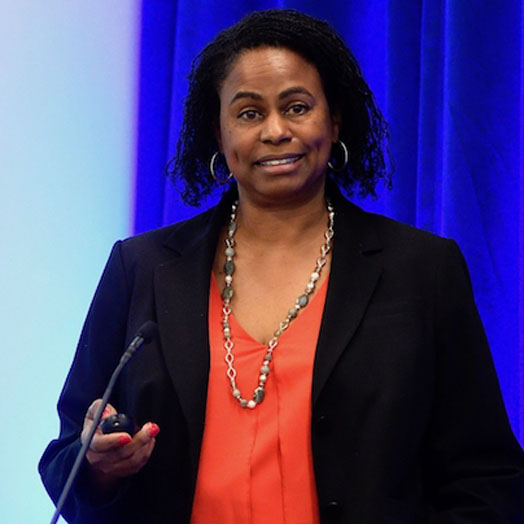Greater Inclusiveness Key to Technology Growth Potential, According to Summit Speaker
In order to realize technology’s great promise in advancing the human condition, it needs to be practiced by a workforce truly representative of that condition, according to Brenda Darden Wilkerson, president and CEO of the AnitaB.org (Anita Borg Institute), an organization that connects, inspires, and strives for greater equality for women technologists in business, academia, and government.
Brenda Wilkerson
Wilkerson delivered her remarks, entitled “How Diversity in Tech Can Save the World and How You Can Make It Happen,” as the keynote speaker at the Johns Hopkins Carey Business School’s recently conducted Diversity and Inclusion Summit.
“As ubiquitous as technology is to our way of life, we need every perspective and point of view at the table to help make sure that that way of life is a good one for all of us,” she said.
Prior to joining Anita Borg, Wilkerson was director of Computer Science and IT Education for Chicago Public Schools, working to make computer science not only “democratized” but also “normalized.” The result was the Computer Science for All initiative, which built computer science classes into the curriculum for every student.
Despite gains in recent years, computer science classes are still absent in most public school systems, especially in areas that serve primarily underrepresented student populations. Wilkerson cited statistics that indicate three in four schools don’t offer computer science courses, yet 71 percent of all new STEM (Science, Technology, Engineering, Math) jobs are in the computer science field.
An equally daunting challenge is boosting the number of women in the field, especially women of color. Often, the very existence of such courses, and consequent careers, are not promoted to women. Wilkerson relates the story when, as a biomedical engineering major in college, she was required to take two computing classes, effectively discovering the field by happenstance.
As ubiquitous as technology is to our way of life, we need every perspective and point of view at the table to help make sure that that way of life is a good one for all of us.”
Brenda Wilkerson | CEO, Anita Borg Institute
“That was my first experience with computer science. It actually changed my trajectory a bunch,” she remembers. “This should not be an accident that computer science changed the trajectory of my life. It should have been a choice.
“Computers and technology permeate every facet of our lives,” observed Wilkerson. A lack of access to computer science education, at this point in our history, is “akin to denying a human right,” just like the right to learn math and reading, she added. “If these skills are offered to a narrow band of the population, technology will mirror that."
One of the initiatives Wilkerson is most proud of is BRAID (Building, Recruiting, And Inclusion for Diversity), where her organization works with computer science departments in several colleges across the country to make sure those departments and their offerings are much more conducive and opening to female and underrepresented group populations.
Wilkerson also spoke of the importance of “intersectionality,” a concept that goes beyond race and gender to speak to the many facets of an individual that can impact that person’s experience. She gave an example relevant to the tech industry: biometrics, specifically the burgeoning field of facial recognition. The industry has experienced significantly higher error rates for darker-skinned individuals, thereby jeopardizing people’s safety, careers, even their lives. Many times technology, pointed out Wilkerson, is “not tested for the greater human condition,” underlining the importance of building diversity into the equation when such tech is first imagined and developed.
“Tech solves problems. But people build tech,” she said.
When you see a barrier, address it. When you a see a room that’s very homogeneous, challenge it … We need technology that solves the problems of the human condition, and we will get that with more diverse people at the table.”
BRENDA WILKERSON | CEO, ANITA BORG INSTITUTE
Wilkerson also stressed that the source of technological problem solving is critical to the problem being solved. As an example, she related the story of Jessica O. Matthews, a first-generation American of Nigerian descent, who addressed that country’s electricity shortage by inventing ingenious kinetic energy storage methods including soccer balls and jump rope sets. Others would not have come up with this solution, observed Wilkerson, because Matthew’s experience and culture (and resultant recognition of need) was foreign to them.
“Solving problems by people who understand the need … [was] “the biggest reason I fought so hard for computer science education in Chicago Public Schools,” said Wilkerson.
Wilkerson also pointed out that, ironically, many early computer science pioneers in the field were women (before the field formally existed), but as it developed and expanded, academic training only became available to men. The problem is compounded when young minority women see only men, especially white men, in the field.
Wilkerson left her audience with this challenge: “When you see a barrier, address it. When you a see a room that’s very homogeneous, challenge it … We need technology that solves the problems of the human condition, and we will get that with more diverse people at the table.”
The Diversity and Inclusion Summit at Carey was held to explore opportunities for growth and development, in business education and commerce broadly, for people of all backgrounds. The aim of the summit was to promote thoughtful discussion of the importance of diversity and inclusion to business and society.



